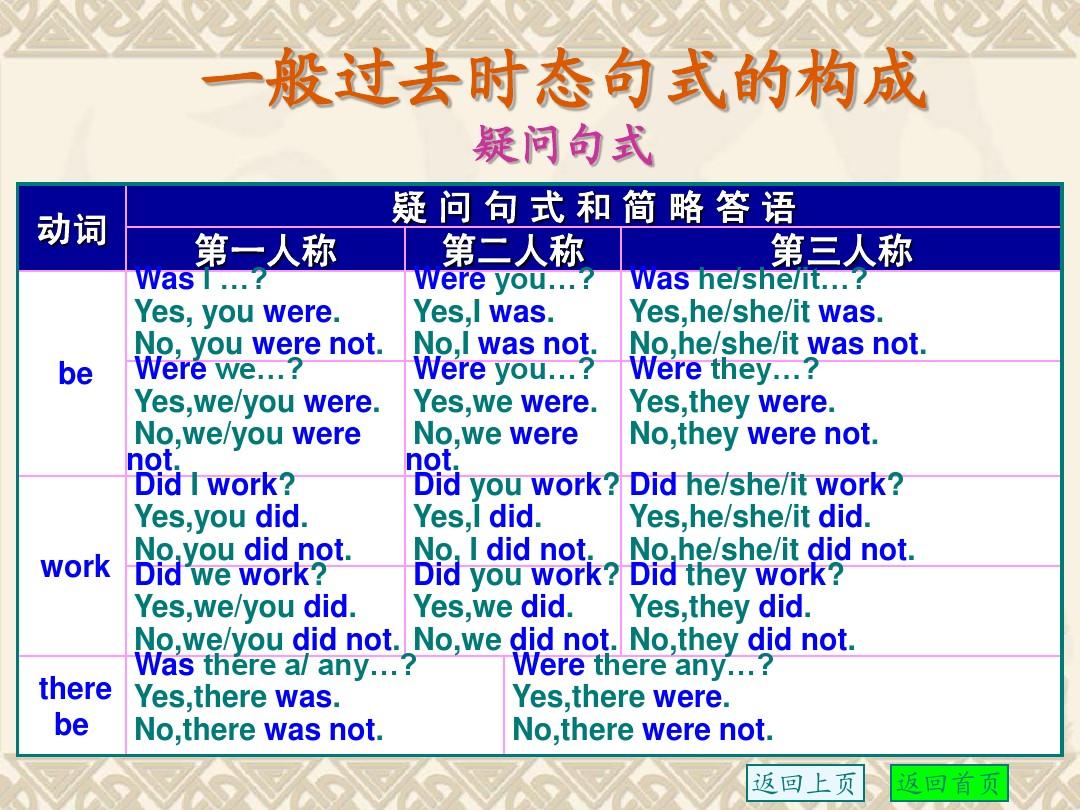基本介紹
- 中文名:一般過去時
- 外文名:Simple past tense
- 概念:過去某個時間裡發生的動作或狀態
- 注音:yi ban guo qu shi
- 繁體:一般過去時
含義,動詞變化,句法結構,肯定形式,否定形式,一般疑問句,特殊疑問句,被動語態,記憶口訣,用法,時間狀語,一般形態,Be 動詞,實義動詞,助動詞和情態動詞,語法講解,句式變化技巧,
含義
- 過去某個時間裡發生的動作或狀態。
- 過去習慣性、經常性的動作、行為。
- 過去主語所具備的能力和性格。
動詞變化
| 情況 | 方法 | 示例 |
|---|---|---|
一般情況 | +ed | work—— worked look——looked |
以不發音e結尾 | +d | live ——lived hope——hoped |
以輔音字母+y結尾 | 變y為i+ed | study—— studied carry——carried |
以重讀閉音節結尾且末尾只有一個輔音字母 | 雙寫最後的輔音字母+ed | stop—— stopped plan——planned |
以ic結尾的動詞 | 變ic為ick+ed | picnic——picnicked traffic——trafficked |
特殊情況 | 不規則 | are---were is/am---was do---did |
句法結構
肯定形式
主語+動詞過去式+其它
例句:She often came to help us in those days.
否定形式
①was/were+not;②在行為動詞前加didn't,同時還原行為動詞
例句:I didn't know you like coffee.
一般疑問句
例句:Did I do homework?
特殊疑問句
疑問詞+was/were+物主代詞/...'s+sth.?
被動語態
主語 + was / were + 動詞的過去分詞
用表格整理如下:
| 肯定式 | 疑問式 | 否定式 | 疑問否定式 |
|---|---|---|---|
I worked | Did I work? | I did not work | Did you not work? |
He(She,It) worked | Did he(she,it) work? | He (she,it)did not work | Did he(she,it)not work? |
We worked | Did we work? | We did not work | Did we not work? |
You worked | Did you work? | You did not work | Did you not work? |
They worked | Did they work? | They did not work | Did they not work? |
記憶口訣
一般過去時並不難,過去動作、狀態記心間。
動詞要用過去式,時間狀語句末站。
否定句很簡單,didn't 站動原前,其它部分不要變。
一般疑問句也好變,did放句子前,主語、動原、其它部分依次站立。
特殊疑問句也簡單,疑問詞加一般疑問句記心間。
一般過去時表示過去某個時間或某一段時間內發生的動作或存在的狀態,常和過去的時間狀語連用。
用法
- 表示過去連續發生的動作時,要用過去時。這種情況下,往往沒有表示過去的時間狀語,而通過上下文來表示。
The boy opened his eyes for a moment,looked at the captain,and then died.那男孩把眼睛張開了一會兒,看看船長,然後就去世了。 - 表示在此之前一段時間內經常或反覆的動作。常與always,never等連用。
Mrs. Peter always carried an umbrella.彼得太太過去老是帶著一把傘。
(只是說明她過去的動作,不表明她是否常帶著傘。)
比較
Mrs. Peter always carries an umbrella.彼得太太總是帶著一把傘。
(說明這是她的習慣,表明她仍然還習慣總帶著一把傘)
Mrs. Peter is always carrying an umbrella.彼得太太總是帶著一把傘。
(表示說話者對這一動作或行為厭煩) - 如果強調已經終止的習慣時要用 used to do(過去常常做,而不那樣做了)
He used to drink alcohol.他過去喝酒。(意味著他不喝酒了。喝酒這個動作終止了)
I used to take a walk in the morning.我過去是在早晨散步。(意味著不在早晨散步了)
比較:
I took a walk in the morning.我曾經在早晨散過步。(只是說明過去這一動作)
I never drank wine.我以前從不喝酒。(不涉及到說明現在是否喝酒) - 有些句子,雖然沒有表示過去確定時間的狀語,但實際上是指過去發生的動作或存在的狀態的話,也要用過去時,這一點,我們中國學生往往出錯,要特別注意!
I didn''t know you were in Paris.我不知道你在巴黎。
(因為在說話時,我已經知道你在巴黎了。這句話指的是說話之前,所以只能用過去時表示。實際上,這句話暗指:But now I know you are here.)
I thought you were ill.我以為你病了呢。(這句話應是在說話之前,我以為你病了。但是我知道現在你沒病)
時間狀語
- yesterday (morning,afternoon,evening)
- the day before yesterday
- last night (week,Sunday,weekend,month,winter,year,century 世紀)
- ago
- this morning/afternoon/evening
- when引導的狀語從句(動詞過去時)
- just now
- the other day -- a few days ago.
- at the age of 10 (過去年齡段)
- in the old days
- at that time
- in+整十數年份+s(⋯世紀⋯年代)
- used to do... (過去做...)
一般形態
Be 動詞
Be 動詞的一般過去時態.
在沒有實義動詞的句子中使用be動詞, am is 的過去式為was; are的過去式為were.
構成:肯定句:主語+was (were) +表語
如:I was late yesterday. (昨天我遲到了。)
否定句:主語+was (were) +not+表語
如:We weren't late yesterday. (我們昨天沒有遲到)
【注意】:當句中含有系動詞was,were時,可直接在其後加not構成否定句。如:I was on the Internet
when you called me.當你打電話給我時,我在上網。→ :I was not/wasn't on the Internet when you called me .當你打電話給我時,我不在上網。
疑問句:Was (Were) +主語+表語當謂語動詞提前並直接或間接表達注意時態
特殊疑問句:特殊疑問詞+was (were) +主語+表語
在沒有實義動詞的句子中使用be動詞, am is 的過去式為was; are的過去式為were.
構成:肯定句:主語+was (were) +表語
如:I was late yesterday. (昨天我遲到了。)
否定句:主語+was (were) +not+表語
如:We weren't late yesterday. (我們昨天沒有遲到)
【注意】:當句中含有系動詞was,were時,可直接在其後加not構成否定句。如:I was on the Internet
when you called me.當你打電話給我時,我在上網。→ :I was not/wasn't on the Internet when you called me .當你打電話給我時,我不在上網。
疑問句:Was (Were) +主語+表語當謂語動詞提前並直接或間接表達注意時態
特殊疑問句:特殊疑問詞+was (were) +主語+表語
實義動詞
助動詞和情態動詞
助動詞和情態動詞過去式如下:
shall―should(將要)用於第一人稱單數
will―would(將要)用於所有人稱
can—could(能,會) may―might(可以) must―must (必須)
have to―had to(不得不)
助動詞和情態動詞的過去時態要使用他們的過去式,後面的動詞還使用原形。
如:I had to do my homework yesterday. (昨天我不得不做作業。)
shall―should(將要)用於第一人稱單數
will―would(將要)用於所有人稱
can—could(能,會) may―might(可以) must―must (必須)
have to―had to(不得不)
助動詞和情態動詞的過去時態要使用他們的過去式,後面的動詞還使用原形。
如:I had to do my homework yesterday. (昨天我不得不做作業。)
語法講解
一般過去時也叫單純過去時。
例A:Mr. Smith bought a new car yesterday.
(史密斯先生昨天買了一輛新車。)
例B:They were here only a few minutes ago.
(幾分鐘前他們還在這裡。)
一般過去時的用法如下:
一般過去時最明顯的現象就是常由表達過去之時間的副詞或副詞短語來修飾它(如各例句的斜體字部分)。這些常用於修飾一般過去時的副詞有:yesterday,yesterday morning (afternoon,evening ),just now (剛才),before (以前), then(at that time ) (當時),last +時間 (如 last week,month,year,Monday,… January,… spring,…,etc. ),that +時間 (如 that day,afternoon,summer,…,etc. ),時間 + ago (如 a few minutes ago,two weeks ago,years ago,… etc.)
“過去”的概念並不是只指如 “yesterday,last week,… ” 等,實際上“與現在對立的過去”,亦即“非現在的以前”,哪怕是“過了說話時間的幾分鐘之前”,只要所要表達的時間與說話時的“現在”形成對立,就必須使用一般過去時來表達。例如:
He was here only a few minutes ago.
(僅僅幾分鐘前他還在這裡。)
I came home just now.
(我剛回到家。)
在A項我們說明了“this + 時間, today,etc.”的時間副詞常用於修飾一般現在時,但是實際上只要是“與說話時的現在”對立,就必須使用一般過去時。例如:
I got up very early this morning.
(今天早晨我起床很早。)
He was late for school again today.
(今天他又遲到了。)
主 語 | 肯 定 式 | 否 定 式 | 疑 問 式 |
第一、二人稱和第三人稱複數以及名詞複數 | I was a student. We/You/ They were students. He/ She was a student. I / We/ You/ They/ liked music. Many people liked music. | I was not a student. We/You/ They were not students. He/ She was not a student. I / We/ You/ They/ didn’t like music. Many people didn’t like music. | Were you a student? Were you/ they students? Was he/ she a student? Did you/ they like music? Did many people like music? |
3)一般過去時的用法:
1. 過去發生的動作。例如:
The police stopped me on my way home last night.
2. 過去存在的狀態。例如:
They weren't able to come because they were so busy.
3. 常用於一般過去時的時間狀語:
yesterday,three months ago,last year,in 1979,once upon a time(很久以前),long ago,then(那時)等。
例題解析:舉一反三,學的更輕鬆!
1. Mott is out. But he ______ here a few minutes ago.
A. was B. is C. will be D. would be
解析:幾分鐘前發生的動作, 應該用一般過去時。應選A,
2.---Hi,Tom.
---Hello,Fancy. I ______ you were here.
A.don't know B.won't think C. think D. didn't know
解析:雖然句中沒有明確的時間狀語, 但是可以通過上下文語境判斷出, 我說這話之前不知道,但是現在知道了,表示的動作,要用過去時態。所以選D。
3.He promised to tell me by himself when I ______.
A. come B. would come C. came D. had come
句式變化技巧
- 一變:肯定句變為否定句
【技巧1】當句中含有情態動詞或助動詞could,would,should等時,可直接在其後面加not構成否定句。例如:
I could get you a concert ticket. → I could not / couldn't get you a concert ticket.
【技巧2】當句中含有系動詞was,were 時,可直接在其後加not構成否定句。例如:
I was on the Internet when you called me. → I was not / wasn't on the Internet when you called me.
【技巧3】當句中謂語是除情態動詞、助動詞、系動詞was,were以外的動詞時,在該動詞之前加did not / didn't,動詞還原,構成否定句。例如:
The famous singer sang some Chinese songs. → The famous singer did not / didn't sing any Chinese songs. - 三變:陳述句變為特殊疑問句
【技巧1】確定疑問詞:人who / whom,物what,地點where,時間when / what time,原因why,頻率how often,長度how long,距離how far等等。例如:
They gave the concert last night. → When did they give the concert?
【技巧2】辨認結構形式:疑問詞+情態動詞/助動詞/ was / were / did +主語+...? 例如:
The accident happened near the station. → Where did the accident happen - 一些不規則變化:
do>did see>saw make>made take>took eat>ate
read>read put>put get>got hear>heard feel>felt
is/am---was are---were teach---taught catch---caught
buy---bought go---went come---came become---became等

